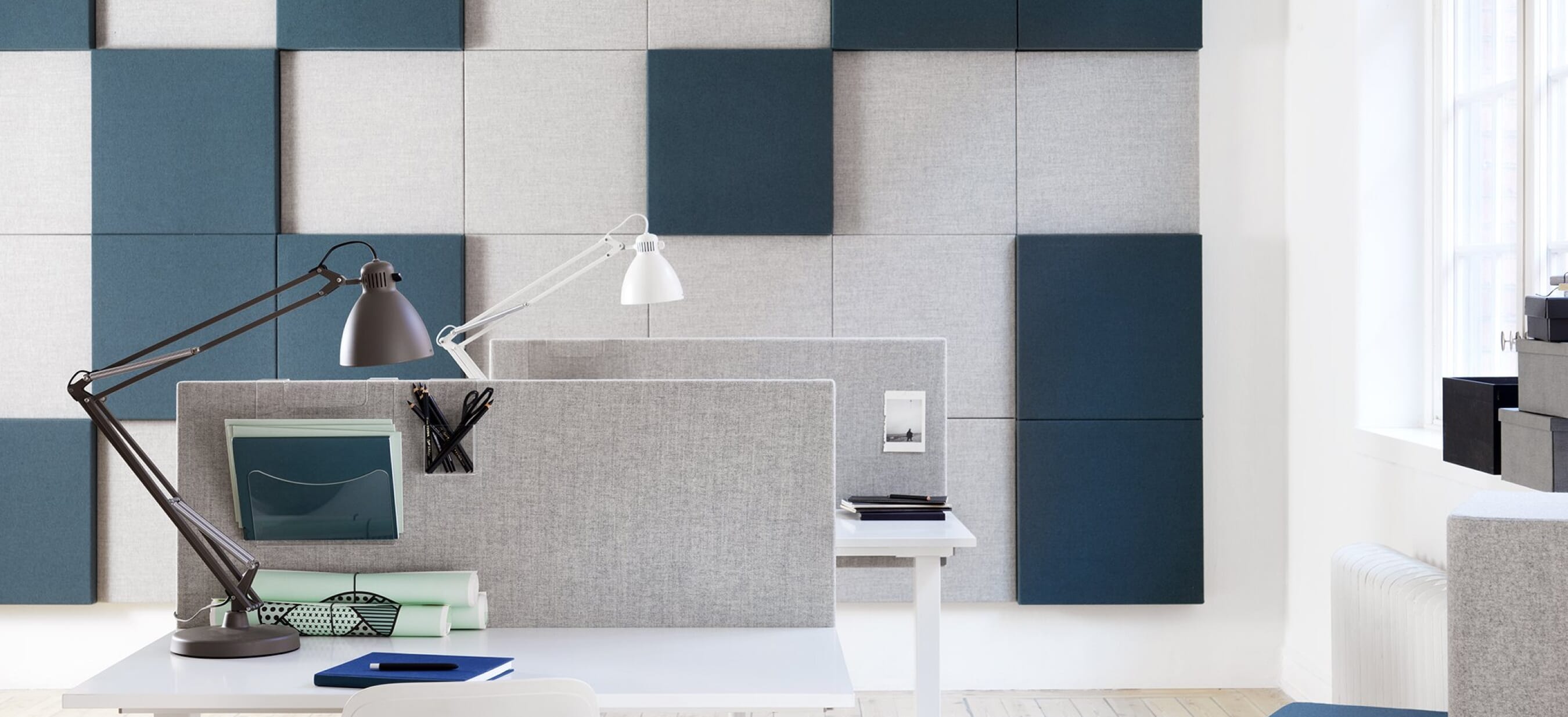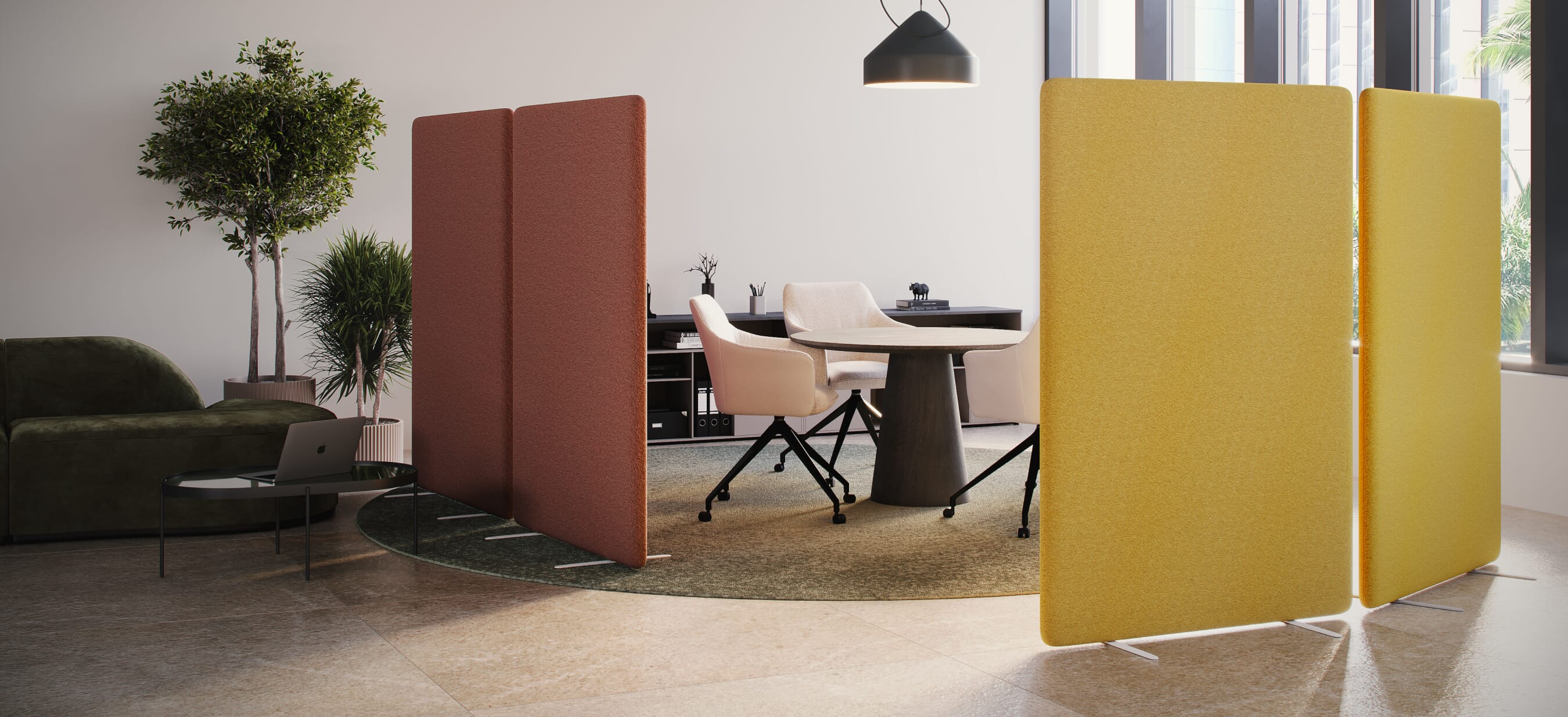Acoustics 101: Room Acoustics Terms Explained
Room acoustics are not to be ignored, especially in open-plan professional environments. Now that modern employers have started considering the physical and mental state of their employees, room acoustics has entered mainstream consciousness. But what does it mean?
Room acoustics encourage us to consider the complicated interplay between echoes, reverberations, sound barriers, materials, heat sources, and people in any given space. This concept is especially important for office spaces, where millions of us spend most of our waking hours.
This guide will teach you:
- The definition of important sound terms
- The difference between building acoustics and room acoustics
- Starting points for good acoustics
What Is Sound?
Most of us take sound for granted, so when someone asks, ‘What is sound?’ it’s not uncommon to be confused.
Sound is a vibration that travels in waves. Sound waves enter our ear canal, which vibrates from the incoming waves. Our ear canal translates the vibrations into electrical signals which our brain interprets as sound.
Sound waves can travel through lots of different mediums.
Sound Frequency and Hertz
Sound frequency is the rate the sound wave current changes direction per second, and it is measured in Hertz. The greater the number of changes per second, the greater the Hertz, frequency, and tone.
Frequency determines the tone. The higher the frequency, the higher the tone.
What Is a Decibel?
A decibel (dB) measures the volume of a sound. Decibels are not to be confused with Hertz, which measure the frequency of the sound.
Objects can have the same Hertz, but different Decibels.
Human Hearing
Humans can hear anything from 0 dB to 20,000 dB, but the normal range is thought to be 0 dB to 180 dB. It is widely accepted that anything over 70 dB can harm your ears and even cause hearing loss.
Frequency of Everyday Items
- Hoover - Hoovers range from 60 to 85 dB, which is why some people choose to wear earplugs when they clean.
- Coffee machine - The coffee machine in your office could be spouting out around 80 dB of background noise.
- Television - Typical remote controls can reach up to 70 dB, which is the level where hearing damage becomes a real possibility.
- Dishwashers - Dishwashers might be louder than you think, clocking in at 55 to 70 dB.
- Hairdryer - Your hairdryer could put you at risk of hearing damage! That’s right, hairdryers produce up to 85 dB of sound.
Why Do Decibels Matter?
When you first step into the world of acoustics, you might be surprised to discover how loud everyday items are. The truth is that even the most inconspicuous object can cause hearing damage.
Office workers know this more than most. Lots of modern offices are open-plan, so employees have to deal with an onslaught of noise from every direction.
How Background Noise Impacts Concentration
Research shows that when exposed to noise at 95 dB, visual and auditory attention is greatly reduced. In simple terms, distracting noises can stop you from meeting deadlines and your own personal goals. If you are hoping for a promotion, you need to create a serene soundscape.
Reverberation Explained
Reverberation happens when sound waves bounce off objects and create a prolonged sound. Reverberation time is the time it takes for a sound to ‘fade away’ or, in more technical terms, decay by 60 dB. This key aspect of room acoustics is expressed in seconds.
Different spaces need different reverberation times.
- Classrooms - 0.6s
- Large lecture halls - 1.0s
- Intimate restaurants - 0.7s
- Sports bars - 1.1s
- Conference rooms - 0.6s
- Open workspaces - 0.5s
To achieve a precise level of reverberation, interior designers invest in sound-absorbing materials, panels, carpets, and so on.
Building Acoustics vs. Room Acoustics
Building acoustics and room acoustics sound self-explanatory, but there is a bit of confusion. After all, they both lead to the same thing, right? Wrong.
Building acoustics is a concept that focuses on the transmission of sound from outside to inside and between floor levels. To get a comprehensive view of building acoustics, we also have to consider the materials that were used in the construction of all the different elements.
Examples of building acoustics include:
- The sound of an airplane flying overhead
- The sound of a construction machine working outside
- The sound of music from a different room in the building
To solve the problem of building acoustics, architects have to strategically place insulation in walls, floors, and rafters.
On the other hand, room acoustics focuses on sounds that are within the room.
Examples of room acoustics include:
- The sound of deskmates talking
- Background noise from keyboards clacking
- Echoes from poorly balanced room acoustics
To solve room acoustics, interior designers have to strategically place sound-absorbing materials around the room.
How Acoustic Furnishings Help
Sound-absorbing materials are the answer to all your soundscape problems. Our acoustic furnishings are designed to do one (or both) of these essential noise-reducing things.
Attenuate sound - Sound attenuation is the loss of energy from sound waves. Sound waves hit our acoustic panels (which are upholstered in extremely porous, acoustically transparent materials), and become trapped inside millions of miniscule holes as they travel through the material. The waves lose energy, which means that they become less frequent and have less volume.
Diffuse sound - Sound diffusion happens when sound spreads out. If your room echoes, you may need to use strategically placed furniture, carpets, and curtains to diffuse sound waves in difficult spots.
Room Acoustics Consultation
Room acoustics can be confusing, especially if you have no experience in interior decoration. Our acoustics experts will help you plan your room to create a serene soundscape. Outline your project on our online form and we will get back to you as soon as possible.

Pick Our Brains
Do you want to learn about acoustic panels, screens or furnishings, for your space? Book a consultation with us today to see how you can soften your soundscape and find effective furnishings.
Contact us

